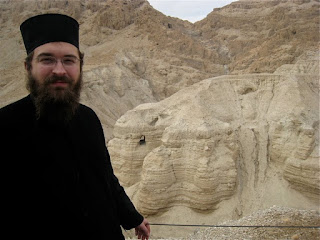After only a couple hours sleep, we were up and out again to meet a van outside Damascus Gate at 7:00 AM. We had booked a day "tour" (basically just transportation in a passenger van) south to the Dead Sea. The first stop was Qumran, located on the northwestern shore of the Dead Sea. We arrived just as it opened at 8:00 AM and enjoyed the fact that there were relatively few tourists there.
It is almost certain that this site is connected with the Dead Sea Scrolls, which were found about 60 years ago in caves overlooking the settlement. They, and this settlement, date to around the time of Christ and provide important information about Jewish movements at that time.
Again, it is almost certain that the group that inhabited this site and produced the Dead Sea Scrolls were Essenes, a third major Jewish sect besides the Pharisees and the Sadducees (who are referred to in the New Testament).
At the site, the Israeli National Parks played a video which strongly suggested that St. John the Baptist had once been a "novice" in this monastic-like community, but left abruptly. This is based on one of the texts found in the caves which refers to a community meeting in which a certain "John," who left abruptly, was debated. While this theory was briefly famous (probably after some popularizer made this huge leap in order to gain a name for himself or sell a few books), the majority of scholars consider it unlikely.
Here is what appears to be a ritual bath.
Behind me you can see some of the caves in which the scrolls were discovered by accident by a Bedouin boy. The story of how the Bedouins sold these scrolls to collectors is fascinating. At one point, there were being paid for by the piece, so the Bedouins were actually tearing up whole scrolls into fragments in order to get more money. Scholars then spent years piecing them back together.
After Qumran, we headed down the west coast of the Dead Sea to its southwestern corner and the fortress of Masada. There, a huge plateau with sheer cliffs rises up, making it an ideal place for a fortress. Herod, a megalomaniacal builder and rather paranoid, built this fortress as a potential refuge in case the Jews should turn against him.
The photo above is of the cable car which zips you up and down.
Looking down from the top. It was actually sunny and hot up there (yes, on January 1), so my dad got a hat for some protection from the sun.
You get a sense here of the sheer cliffs which act as a natural protection for the fortress, in which Herod built not one but two palaces for himself.
Of course, Masada is most famous as the site of the last holdouts from the Jewish rebellion which destroyed the Second Temple and all of Jerusalem in 70 AD. Some 950 Jewish rebels (possibly belonging to the Sicarii faction of the Zealots) held out here until 73 AD, when the Romans laid siege to them for several months and actually constructed a ramp up the side of the cliff (see photo above). They then pushed a large wheeled siege tower up the ramp and used it to break through the walls. According to the popular version of the story, the Jews chose mass suicide rather than surrendering to the Romans.
In some of my photos you can made out square or diamond shaped figures in the sands. These are the remains of the several Roman army camps that were set up during the siege in 73 AD. Since sieges would last so long that the armies would build up impromptu towns with their own stores, etc.
During the fifth and sixth centuries, the Byzantines used the site as (you guessed it!) a monastery. It never seems to have been very big, though. These caves here (which served as cells) are pretty much the extent of the monastery, along with a small church nearby.
This is an interesting aerial 3D tour of the site.
For more photos from the fourth day, click here.










No comments:
Post a Comment